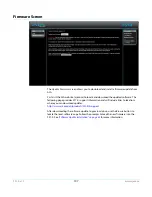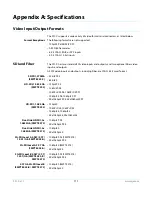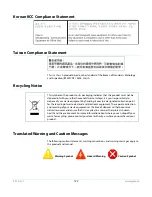
FS1-X v1.1
www.aja.com
108
Chapter 6: SNMP
FS1-X Simple Network Management Protocol
SNMP is defined as a “simple network management protocol” and was specified as a
component of the internet protocol suite by the Internet Engineering Task Force (IETF).
The FS1-X can act as a
network element
that issues SNMP trap messages signaling a
detected alarm condition or other system condition. A device’s trap messages are
defined in an MIB (Management Information Base) file. The trap messages are sent to a
server-based external NMS destination. For example, the FS1-X could send a trap
message if one of its redundant power supplies becomes unplugged. A client software
agent that communicates with the NMS might then get a message telling the operator
what has happened.
The FS1-X must be configured for SNMP messaging. By default SNMP is disabled on the
FS1-X. Besides activating SNMP, trap destinations must also be defined with fixed IP
addresses.
When SNMP is enabled, one or more of these alarms may be sent by the FS1-X to the
client network management system (NMS) as a trap message:
• FS1-XPowerSupplyAlarm (PS1 Alarm)
• FS1-X PowerSupply2Alarm (PS2 Alarm)
• FS1-XReferenceAlarm (Ref Video Alarm)
• FS1-XVid1ReferenceAlarm (Vid1 Ref Video Alarm)
• FS1-XVid2ReferenceAlarm (Vid2 Ref Video Alarm)
• FS1-XVid1FormatAlarm (Vid1 Format Alarm)
• FS1-XVid1BackgroundAlarm (Vid1 Background Format Alarm)
• FS1-XVid2FormatAlarm (Vid2 Format Alarm)
• FS1-XVid2BackgroundAlarm (Vid2 Background Format Alarm)
• FS1-XOverTemperatureAlarm (FS1-X Over Temperature Alarm)
SNMP Configuration
FS1-X SNMP configuration can be accomplished using the front panel or with the web
browser computer interface (if Remote Control is enabled).
Front Panel Screens
The FS1-X front panel screens for SNMP are accessible through the CONFIG button. The
direct SNMP configuration screens are:
• 4.0 SNMP Enable
• 4.1 SNMP Trap Destination 1
• 4.2 SNMP Trap Port 1
• 4.3 SNMP Trap Destination 2
• 4.4 SNMP Trap Port 2
These SNMP direct configuration parameters are described later in this chapter.






























